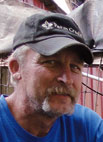
Each farm or ranch has its own specific charm, but Sawoaks outside of Tahlequah, Okla., is like a manicured park with rolling hills, heavy metal fences and dotted with clumps of beautiful red oak trees. The difference is these hills are home to 152 registered Angus with 40 bulls being sold per year. Al Williams started in the late ‘80s with 110 acres that has gradually grown to 575 acres with a beautiful home sitting on the crest of a hill and overlooking picturesque land. The ranch didn’t look like this in the beginning, however. The land had been full of rock, brush, dead trees and other debris, and Al began clearing by using a brush hog. Patience and persistence have paid off in a big way.
Al grew up on a farm but chose a different career. Al said, “I’m a country boy and grew up raising cotton, corn and hay. I remember chopping cotton when I was 6 or 7 years old, and that was no fun. That’s why I went off to college.” He did undergraduate work at Northeastern State Oklahoma University, his Masters at University of Kansas, and his PhD at the University of Tulsa in counseling psychology. He retired as vice president of Northeastern State Oklahoma University and served as president of Oklahoma Counseling Association and the Angus Association of Oklahoma. Now Al, who is 76, enjoys working with his herd full-time when he’s not traveling. Al said, “It’s getting to the point where I can’t take care of that many cows by myself and you just can’t get help. I can’t afford to pay adult wages but kids simply don’t want to work.”
Al bought his first Angus when he was close to 30 and had a brother, a crop farmer, take care of them until he got his own place in order. At the time the national Angus campaign was beginning to gain strength and Angus bulls were a wise investment because they turn everything black, exactly what the market was looking for. As a result now most Limousin and Simmental have pretty much gone to totally black. Al continued, “However, all black hides are not the same, and certified Angus beef sells very well.”
Al artificial inseminates his herd unless it’s very hot because experience has taught him that it’s very difficult to catch cows at the right time when temperatures are soaring. Al said, “You can’t afford a bull that is as nice as you can artificial inseminate to.” He started with artificial insemination in 1991 and went to school but really learned from an old Baptist preacher. This year he achieved a 70 percent pregnancy rate during the first round of artificial insemination and will artificial inseminate one more time before using a cleanup bull. Al uses two calving seasons, spring and fall and buys a few cows every year. In addition, 95 percent of his calves are born between 70 and 75 pounds, an ideal weight. He culls by temperament in order to keep the animals easy to work with.
Al has seen changes in the breed through the years. He believes more science is now involved and works toward producing a more marketable animal without making animals too fat. Wholesalers are seeking large carcasses that weigh 1,200 pounds slaughtered with good marbling but less outside fat he believes in using commodity feed rather than corn in order to control the amount of fat. He uses a mixture of soy hulls, cottonseed pellets and corn gluten with a 14 to 15 percent protein content.
Another important part of keeping top-quality animals is good pasture. Consequently Al tests his soil every year, and the tests have shown that unlike some other farms all he needs is nitrogen which he applies annually.
High-quality hay is also important for Al’s operation and he purchases all of the hay he uses so his land can be used for pasturing about 100 momma cows. Because local hay is Fescue and Bermuda, he buys his hay from Missouri. He typically purchases a couple of loads of alfalfa and 4 to 5 loads of a Timothy and Brome mixture. Al said that being able to feed the cattle economically enough to make money is a big challenge.
Al concluded, “The truth is I am in the people business, not the cattle business. The cows are the product and other cattlemen are the customers. If I can’t relate to cattlemen, I’m finished.”







